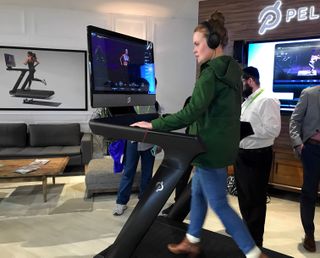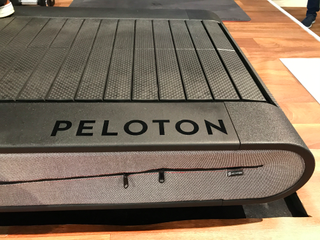Don't Laugh: Why You'll Want to Buy Peloton's $4,000 Treadmill
Peloton's connected treadmill aims to swap your gym membership for live-streamed classes. Your wallet won't like it, but your waistline might.
LAS VEGAS -- Fitness company Peloton is giving the home gym equipment you’ve seen on late-night infomercials a complete makeover. Instead of sadly attempting to tone your abs at home on a machine that looks like a medieval torture device, you can use Peloton’s stationary bike and its just-announced treadmill. It's like working out in a gym class, which is why the new Tread machine is so expensive — $3,995, to be exact.

Tread’s price tag might seem ludicrously high for most people, even those of us who care about our fitness. But Peloton is taking the iPhone X approach to marketing its treadmill. If you spread out the payments over 39 months, it’s only $149 a month. (Only.)
There's also a $39 monthly subscription for live-streamed fitness classes taught by instructors in Peloton’s Manhattan studio. The installment plan and monthly service replace the cost of a monthly gym membership for two people.
That’s how Peloton plans to sell both gym buffs and running newbies on the Tread. I tested out the machine at CES, and I’m already trying to find ways to justify buying this $4,000 treadmill that I don’t have the space or money for.
MORE: Best Fitness Trackers for Running, Swimming and Training
What really sets Peloton’s Tread apart is its 32-inch display. Most gym treadmills have a screen where you can watch TV or view your stats while you jog, but Peloton’s screen livestreams 10-15 classes a day.
It’s more convenient than going to the gym, because you don’t have to leave your house. The workouts are guided by people who know what they’re doing, unlike those of us at home. There’s even a social element: a leaderboard where you can compete against anyone who’s ever taken a class, which range from 20-minute runs (yes, including sprints) to full-body workouts using weights, and a yoga mat in addition to cardio.
"This transforms a home workout from the Jane Fonda method of one-way interaction into something that’s new every day," Peloton chief operating officer and cofounder Tom Cortese told me at CES. "There’s always new content. You’re always gonna have the newest music. If there’s a unique way we’ve thought about how to teach a class, we’re gonna use it."
You also get access to workouts on Peloton’s iOS app if you’re on the go and don’t have access to your machine.
The tread itself is more comfortable than the hard plastic of a gym treadmill, which actually hurts my feet if I run indoors multiple days in a row. Peloton uses a rubber slat belt, which is more cushioned than a plastic-covered wood or aluminum tread.
Tread has a large knob on the left and right side of the machine so you can slowly adjust speed and incline, or throw the treadmill into a sprint with a quick spin. It’s much easier than stabbing at a tiny screen attached to a gym treadmill.
There’s also a manual mode in which you use your own body weight to move the treadmill. This seemed hard to do, but I didn’t try it.

Tread is obviously a thoughtfully designed machine. The display is large and bright, the music is always on point, and the instructors are fitspirational, with more toned muscles than I will ever have in my life. It’s easy to see the appeal of Peloton’s machines.
"The most convenient place to work out is at home," Cortese said. "Before Peloton, it was an awful, boring endeavor."
Working out at home is definitely cheaper without a $4,000 treadmill. But when Peloton Tread ships this fall, you may find yourself rationalizing those monthly payments.
Sign up to get the BEST of Tom’s Guide direct to your inbox.
Upgrade your life with a daily dose of the biggest tech news, lifestyle hacks and our curated analysis. Be the first to know about cutting-edge gadgets and the hottest deals.
Caitlin is a Senior editor for Gizmodo. She has also worked on Tom's Guide, Macworld, PCWorld and the Las Vegas Review-Journal. When she's not testing out the latest devices, you can find her running around the streets of Los Angeles, putting in morning miles or searching for the best tacos.
